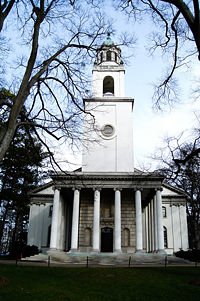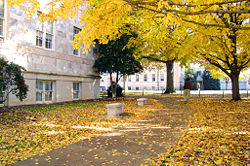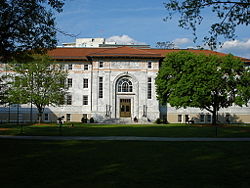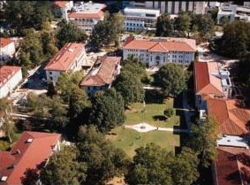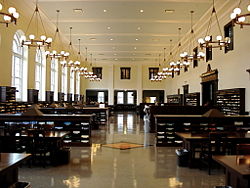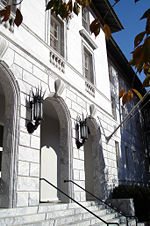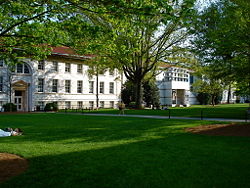Emory University
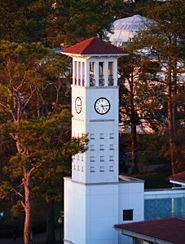
| |
| Motto | Cor prudentis possidebit scientiam (The wise heart seeks knowledge, Proverbs 18:15) |
|---|---|
| Established | 1836 |
| Type | Private |
| Location | metro Atlanta, Georgia USA |
| Website | http://www.emory.edu |
Emory University is a private university located in the metropolitan area of the city of Atlanta and in western unincorporated DeKalb County, Georgia, United States. Founded in 1836 and named after John Emory, a popular bishop of the Georgia Methodist Conference, the university maintains its connection to the Methodist Church, while also developing a secular curriculum and administration. The university consists of nine academic divisions including schools of arts and sciences, theology, business, law, medicine, public health, and nursing.
Emory's core commitment since its founding has been to provide an American education that molded character as well as the mind. Today it seeks to accomplish this through promoting inquiry-driven and ethically engaged teaching and research. Emory students have become a diverse community, and the goal of their education is to that will become leaders who can bring about positive transformation in the world in teaching, scholarship, health care, and social action. Founded as a Methodist college, the university has a spiritual and moral grounding of which it is proud. Yet it faces challenges as contemporary society has eroded Christian values in an effort to be tolerant of and support the human rights of all lifestyles. Emory's contribution to society, as with all educational institutions, depends to a large extent on how its moral and ethical underpinnings guide its vision of the future.
Mission and reputation
Founded in 1836 and named after John Emory, a bishop of the Georgia Methodist Conference, Emory University has maintained its connection to the Methodist Church.[1] Yet it has reached out beyond the denomination to provide a nonsectarian education for the benefit of all. The official mission statement of Emory University is: "To create, preserve, teach, and apply knowledge in the service of humanity."[2] The statement goes on to say that Emory strives to achieve this mission by keeping its focus of teaching and research in the core disciplines it has focused on since its founding.[2] The university states that its historic affiliation with the Methodist Church has produced "the conviction that education can be a strong moral force in both society and the lives of its individual members."[2]
Emory is generally considered a shortlist member of the so-called "Southern Ivy League" and consistently ranks among the top universities in the United States. In 2008 the school ranked 18th among national universities according to U.S. News & World Report.[3] However, it was not until recently that Emory started to have a well-established name recognition across the U.S. While always known for excellence in the regional South, its enrollment of students from other regions remained low until the beginning of the twenty-first century. Active recruitment in other parts of the United States, its expanded research facilities, renowned faculty members, and increased interest and active engagement in national and worldwide issues have enhanced its reputation as a leading American university.[4]
History
On December 10, 1836, the Georgia General Assembly granted the Georgia Methodist Conference a charter to establish a college to be named for John Emory, a popular bishop who had presided at the 1834 conference but was killed in a carriage accident in 1835. In 1837, at its first meeting, the Board of Trustees agreed to establish both a "contemplated college" and a proposed new town of Oxford, Georgia. By 1838, Emory College began admitting students.[5] For the duration of the nineteenth century, Emory College remained a small institution which offered students both a classical curriculum and professional training. Its students studied four years of Greek, Latin, and mathematics and devoted three years to the English Bible and the sciences of geography, astronomy, and chemistry. In 1875, the first laboratory-based studies for students commenced, alongside a rise of activity by the college's debating societies. Such debates included the justifiability of war, women's suffrage, the morality of slavery, and prohibition.
Emory College was closed briefly during the American Civil War. In the autumn of 1861, academic activity almost completely ceased when many of the students left to fight in the conflict. During the war, the college's buildings saw duty both as a Confederate hospital and Union headquarters. The school's library and other archives were destroyed. It was not until the summer of 1865 that the campus was able to fully return to its academic functions. By that time the campus was largely in shambles and the college's small endowment was depleted.[5]
In the years following the Civil War, Emory, along with the rest of the South, struggled to overcome financial devastation. A key moment came in 1880, when Emory president Atticus G. Haygood preached a Thanksgiving Day sermon declaring that slavery had been evil and urging southerners to cultivate industrial growth. The printed sermon was read by George I. Seney, a New York banker and Methodist, who responded by giving Emory College $5,000 to repay its debts, $50,000 for construction, and $75,000 to establish a new endowmentâenormous sums for the time.[5]
Emory remained small and financially limited for the next thirty years. In 1913, Bishop Warren A. Candler, a former Emory College president, persuaded the Methodist Episcopal Church, South to make Emory the nucleus of a new university. The General Conference, eager to establish a Methodist university with a school of theology, decided to charter one university east of the Mississippi River and one to the river's west.[5] At the same time, Emory began its long-standing association with The Coca-Cola Company in Atlanta, as the bishop's brother was Asa Griggs Candler, who had gained ownership of the company by purchasing it from the inventor of the drink, John Pemberton. Candler had become wealthy from promoting the popular soft drink and agreed to endow the school with one million dollars. He also convinced the school's administration to move to the Atlanta area and for the Methodist Church to designate the college as its eastern university.[5] The Candler family provided a hilly 75 acres (304,000 m²) in the new emerging Druid Hills neighborhood northeast of downtown Atlanta in DeKalb County, less than a mile from the Atlanta city limits. For Asa's generosity, the campus library at the east end of the quadrangleânow restored to its original 1920s lookâwas named after him.
In light of these developments, Emory College was rechartered by DeKalb County on January 25, 1915, as Emory University, which explains both the dates 1836 and 1915 featured on the school's seal. Henry Hornbostel was chosen to design many of the buildings on Emory University's new campus. His designs incorporated local stone and materials in the Georgia marble and red terracotta tile of the structures, which established the institution's unique architectural character. Emory University first opened its theology and law schools in the new campus quadrangle.
In 1919, Emory College moved from Oxford to DeKalb County. Emory University later added graduate, business, medical, public health, nursing, and dental schools. The Emory Dental School has since been closed. Doctoral studies at Emory University were established in 1946, and the school has continued to strengthen its graduate and professional schools since. In 1949, Alben Barkley returned to Emory to receive an honorary LLD degree and give the commencement address, the first Emory event to be televised.
Formerly an all-male school, in 1953 Emory opened its doors to women. In 1962, in the midst of the American Civil Rights Movement, Emory embraced the initiative to end racial restrictions when it asked the courts to declare portions of the Georgia statutes unconstitutional. Previously, Georgia law denied tax-exempt status to private universities with racially integrated student bodies. The Supreme Court of Georgia ruled in Emory's favor and Emory became officially racially integrated.
Spurred on by the recent expansion of Emory University, Robert W. Woodruffâpreviously the president of the Coca-Cola Companyâand his brother George presented the institution with a gift of $105 million in 1979. Other large donations, including some from the Woodruff Foundation, over the years since have helped expand Emory's research institutions and facilities to the point that by the end of the twentieth century it ranked as one of the largest research universities in the country.
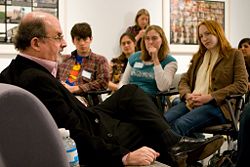
As Emory entered the twenty-first century, a number of distinguished scholars and international figures accepted appointments to its faculty. These included Sir Salman Rushdie, author and literary scholar, who accepted a five-year appointment beginning in 2007.[6] The Dalai Lama (Tenzin Gyatso), Nobel Laureate (1989) who was named Presidential Distinguished Professor in 2007, the first university appointment accepted by him. Emory President James Wagner noted that:
To have a colleague of the Dalai Lama's stature in our community will be a constant source of inspiration and encouragement to our faculty, staff and students as we strive to realize the vision of educating both the heart and mind for the greater good of humanity. His presence will contribute significantly to fulfilling the University's strategic goals, including bringing engaged scholars together in a strong and vital community to confront the human condition.[7]
In 2008, the Emory Board of Trustees officially changed the name of Emory College to College of Arts and Sciences and the name of the Graduate School of Arts and Sciences to Graduate School. The change ended the use of the founding name of Emory College after 172 years.[8]
Facilities
Emory University's campus is located on 600 rural square acres, and combines many historical and modern buildings and infrastructure. Outside of the normal administrative, dormitory, and instructive buildings and halls, the school also has many supplementary structures. The school has five libraries, which have seen enormous growth over the 1990s as they increased their holdings to more than 3.1 million volumes. The Special Collections Department of Woodruff Library houses the papers of the British poet Ted Hughes, as well as an extensive Irish collection (William Butler Yeats, Lady Gregory, Maud Gonne, Seamus Heaney, and several contemporary Irish writers). Emory's Special Collections also has concentrations on southern imprints and writers (James Dickey, Alfred Uhry, Mary Hood, and certain papers of Huey Long, for example), and a growing concentration of African American papers, including the work of activist Malcolm X and the Hatch/Billops Collection. Author Salman Rushdie, who joined the faculty as a Distinguished Writer in Residence, announced that he would donate his extensive archive to Woodruff Library.
The Michael C. Carlos Museum houses a permanent collection of some 18,000 objects, including art from Egypt, Greece, Rome, the Near East, the Americas, Asia, Africa, and Oceania, as well as European and American prints and drawings ranging from the Middle Ages to the twentieth century. Twenty-nine galleries are maintained for permanent collections, and eight galleries present special exhibitions from all periods.
Programs
The College of Arts and Sciences is the undergraduate institution of Emory University with 66 majors, 53 minors, 17 joint concentrations, and 10 interdepartmental programs leading to a bachelor's degree. It enrolls a little more than 5,000 undergraduate students.[9] The Oxford College of Emory University, located in Oxford, Georgia, enrolls about 700 students. Students at Oxford traditionally complete their first two years of their degree at Oxford and then continue at the College of Arts and Sciences (located on the Atlanta campus) to complete their bachelor's degrees. Because of its size, Oxford College provides low student-teacher ratios in classrooms and a close-knit social community typical of liberal arts colleges.[10]
The Graduate School has degree programs in 26 divisions in which students receive either master's or doctoral degrees. The Candler School of Theology is allied with the United Methodist Church, but enrolls students from many denominations. The Goizueta Business School is often recognized nationally for their MBA program. In 2008, Emory Law School was ranked 22nd by U.S. News and World Report.[11]
The Emory Healthcare System is the largest healthcare provider in Georgia and educates doctors, nurses, and other health professionals. The Emory University School of Medicine enrolls approximately 425 medical students, 1,000 residents and fellows, and 350 allied health students. Collaborating with the nearby Centers for Disease Control and Prevention and other public health organizations, the Rollins School of Public Health has about 800 graduate students.[12]
Colleges and Institutes
Approximately half of its students are enrolled in the undergraduate program and the other half are enrolled in one of Emory University's seven graduate programs. Its nine academic divisions include:
- College of Arts and Sciences
- Oxford College
- Graduate School
- Goizueta Business School
- Emory University School of Law
- Emory University School of Medicine
- Rollins School of Public Health
- Nell Hodgson Woodruff School of Nursing
In addition to its nine schools, the university has numerous institutes and centers devoted to research and community outreach. Some of the more prominent of these include:
- Alzheimer's Disease Research Center
- Center for AIDS Research
- Center for Science Education
- Core Laboratories
- Influenza Pathogenesis & Immunology Research Center
- The Carter Center,
- Yerkes National Primate Research Center
- ScienceNET
Student Life
Since the 1960s, Emory's student body has become more regionally and ethnically diverse. According to the school's website, more than 50 percent of its students are from outside the South, with about 30 percent from either the mid-Atlantic or northeast United States. Within Emory College's Class of 2012, 43 percent identified themselves as a member of one or more minority group. Thirty-one percent of the students were Asian, 8.7 percent African American, and 3.5 percent Hispanic.[13] Since the early 1990s, Emory has been one of a few Southern universities to include sexual orientation in its non-discrimination policy. The campus features centers devoted to female students, Jewish students, international students, multicultural students, and LGBT students.[14]
Fraternities on Emory's campus have existed, officially and unofficially, since 1840. Sororities first came to campus in 1959. For undergraduates, Greek life comprises approximately 30 percent of the Emory student population, with the Office of Greek Life at Emory University consisting of 12 fraternities and 13 sororities.[14] For most students, student life includes involvement in one or more of the 320 campus organizations, which includes a nationally ranked chess team and nationally ranked debate team. More than 100 students work for the University's award-winning student newspaper The Emory Wheel and many work for the school's other student publications, including The Hub, The Spoke, Emory Political Review, the Lullwater Review, and the Black Star. Emory also has four secret societiesâthe D.V.S. Senior Honor Society, the oldest society, founded in 1902; Ducemus; the Order of Ammon; and the Paladin Society. Many students volunteer with Volunteer Emory, Emory's large umbrella community service group.
Emory offers intercollegiate teams for men and women in cross country, swimming, tennis, track and field, basketball, and soccer, as well as golf and baseball for men, and volleyball and softball for women. The teams consistently top the UAA standings and are consistently ranked among the best in NCAA Division III, both regionally and nationally.[15] Club sports, recreation, and intramural sports provide additional competitive opportunities. Club teams include crew, rugby, ultimate frisbee, roller hockey, lacrosse, racquetball, volleyball, sailing, and table tennis, among others. Emory's crew, ultimate frisbee and lacrosse teams have had considerable success and deserve particular note. Many intramural sports are also offered at Emory, ranging from basketball to dodgeball and from wrestling to golf, with flag football and soccer being the most popular. The student body participates heavily in athletics, with eighty percent of students participating in intercollegiate, club, recreation, or intramural sports sometime during their time at Emory. Many students also participate in the Outdoor Emory Organization (OEO)âan organization that sponsors weekend trips of outdoor activities, such as rafting, rock climbing and hiking.[15]
Traditions
Traditions at Emory include Dooley, the "Spirit of Emory" and the unofficial mascot of the university. Dooley is a skeleton and is usually dressed in black. The name "Dooley" was given to the unofficial mascot in 1909. Each year in the spring, during Dooley's Week, Dooley roams Emory's campus flanked by bodyguards ("Dooley guards") and lets students out of class with unscheduled appearances in classrooms. He typically walks slowly with an exaggerated limp. A spokesperson amongst the bodyguards walks with him to deliver his messages as he never speaks himself. His identity is unknown and this is often fodder for campus gossip. He adopts the first name and middle initial of the University's current president. For example, his full name has been James W. Dooley, after James W. Wagner. Dooley's Week culminates with Dooley's Ball, a grand celebration that takes place in the center of campus on McDonough Field held in celebration of Dooley and Emory University. A sporting match called the Dooley Cup is played between the university administration and the student government association (SGA) each spring.[15]
Emory's long history with The Coca-Cola Corporation has resulted in the tradition of serving only Coca-Cola and other beverages made by the company on campus. While not enforced by the administration, traditional sentiment frowns upon students, faculty, and staff from drinking other soft drinks while on campus or at a college related event. Pepsi, Coca-Cola's number one competitor in the soda market, is particularly frowned upon from being consumed by those connected to Emory.[15]
Notable Alumni
- Alben W. Barkley - 35th United States Vice President with Pres. Harry S. Truman in 1948. U.S. Senator.
- John B. Cobb - Methodist Process theologian
- James Edward Dickey (class of 1891) - last President of Emory College and first President of Emory University. Later elected a Bishop of the Methodist Episcopal Church, South
- Tinsley Ellis - blues singer
- Lucius Quintus Cincinnatus Lamar (II) - Former United States Supreme Court Justice and Senator from Mississippi
- Gordon Lee (congressman) (class of 1880) - U.S. congressman from Georgia
- Dumas Malone - Pulitzer Prize winning historian, former head of Harvard University Press
- Thomas M. Rivers - Famous virologist, headed the National Science Foundation's search for a polio vaccine
- Robert W. Woodruff - Former President of the Coca-Cola Company (left to work at Coca-Cola after two semesters)
Notes
- â Emory University International Association of Methodist Schools, Colleges & Universities, General Board of Higher Education and Ministry. Retrieved October 19, 2008.
- â 2.0 2.1 2.2 "University Mission Statement" Emory University: Office of the President, 2008. Retrieved October 18, 2008
- â "Best Colleges 2009" U.S. News & World Report, 2008.
- â Megan Woolhouse, Charting Emory's future Atlanta Business Chronicle (September 10, 2004). Retrieved October 18, 2008
- â 5.0 5.1 5.2 5.3 5.4 Thomas H. English. Emory University 1915â1965: A Semicentennial History (Atlanta: Emory University, 1966).
- â Elaine Justice, Salman Rushdie to Teach and Place His Archive at Emory University Emory University, Office of Media Relations, October 6, 2006. Retrieved October 20, 2008.
- â Emory Presidential Distinguished Professor His Holiness the Dalai Lama, Educating the Heart and Mind: A Path to Individual Responsibility, 2007. Retrieved October 20, 2008.
- â Molly Davis, Two Emory Schools Renamed The Emory Wheel, 09/15/2008. Retrieved October 20, 2008.
- â "Emory University" Collegeboard.com. 2008. Retrieved October 18, 2008
- â "Oxford Facts" Emory University, 2008. Retrieved October 18, 2008
- â "Best Graduate Schools" U.S. News and World Report, 2008.
- â "Emory Healthcare" Emory University, 2008. Retrieved October 18, 2008
- â Undergraduate Admission, "Class Profile" Emory University, 2008. Retrieved October 18, 2008
- â 14.0 14.1 Jordan Pope-Roush and Kimberly Moore. Emory University: Off the Record - College Prowler. (College Prowler, 2006, ISBN 1427400598)
- â 15.0 15.1 15.2 15.3 "Emory University" StateUniversity.com, 2008. Retrieved October 18, 2008
ReferencesISBN links support NWE through referral fees
- English, Thomas H. Emory University 1915â1965: A Semicentennial History. Atlanta, GA: Emory University, 1966.
- Gleason, Jan. "Emory ranked 9th-best national university by U.S. News & World Report magazine" Emory Report 50(1) (1997).
- Hauk, Gary S. A Legacy of Heart and Mind: Emory since 1836. Atlanta, GA: Emory University, developed and produced by Bookhouse Group, Inc., 1999.
- Pope-Roush, Jordan, and Kimberly Moore. Emory University: Off the Record - College Prowler. College Prowler, 2006. ISBN 1427400598
- Wilson, C. R., and William Ferris (eds.). Encyclopedia of Southern Culture. Chapel Hill, NC: University of North Carolina Press, 1989. ISBN 0807818232
- Young, James Harvey. "A Brief History of Emory University," Emory College Catalog 2003â2005. Atlanta, GA: Emory University Office of University Publications, 2003.
External links
All links retrieved February 13, 2024.
| Association of American Universities | |
|---|---|
| Public | Arizona ⢠Buffalo (SUNY) ⢠UC Berkeley ⢠UC Davis ⢠UC Irvine ⢠UCLA ⢠UC San Diego ⢠UC Santa Barbara ⢠Colorado ⢠Florida ⢠Illinois ⢠Indiana ⢠Iowa ⢠Iowa State ⢠Kansas ⢠Maryland ⢠Michigan ⢠Michigan State ⢠Minnesota ⢠Missouri ⢠Nebraska ⢠North Carolina ⢠Ohio State ⢠Oregon ⢠Penn State ⢠Pittsburgh ⢠Purdue ⢠Rutgers ⢠Stony Brook (SUNY) ⢠Texas ⢠Texas A&M ⢠Virginia ⢠Washington ⢠Wisconsin |
| Private | Brandeis ⢠Brown ⢠Caltech ⢠Carnegie Mellon ⢠Case Western Reserve ⢠Chicago ⢠Columbia ⢠Cornell ⢠Duke ⢠Emory ⢠Harvard ⢠Johns Hopkins ⢠MIT ⢠Northwestern ⢠NYU ⢠Penn ⢠Princeton ⢠Rice ⢠Rochester ⢠USC ⢠Stanford ⢠Syracuse ⢠Tulane ⢠Vanderbilt ⢠Washington ⢠Yale |
| Canadian | McGill ⢠Toronto |
Credits
New World Encyclopedia writers and editors rewrote and completed the Wikipedia article in accordance with New World Encyclopedia standards. This article abides by terms of the Creative Commons CC-by-sa 3.0 License (CC-by-sa), which may be used and disseminated with proper attribution. Credit is due under the terms of this license that can reference both the New World Encyclopedia contributors and the selfless volunteer contributors of the Wikimedia Foundation. To cite this article click here for a list of acceptable citing formats.The history of earlier contributions by wikipedians is accessible to researchers here:
The history of this article since it was imported to New World Encyclopedia:
Note: Some restrictions may apply to use of individual images which are separately licensed.
